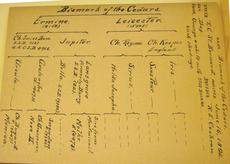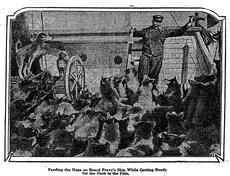

Like a lot of cities in the late 19th century, Washington DC supported a large population of dogs. It's difficult to get an exact count, but conservative estimates placed the number at more than 12,000. This is not an insignificant number, especially when one considers that DC was considerably smaller at the time. About half of these dogs were licensed and tagged, as was required by law, but the remaining half were "vagrant curs" who, legally, belonged to no one. As a control measure, the city asked Poundmaster Samuel Einstein to collect and dispose of as many unclaimed dogs as possible. Throughout the 1880s, Einstein and his agents annually exterminated thousands of stray dogs, yet despite their best efforts thousands more remained at large (Dogs Shot by Wholesale, Washington Post, October 2, 1891, p. 2).
When the Smithsonian established the Department of Living Animals on the National Mall, the event did not go unnoticed among the city's free-ranging canids. Early in 1889, a roving Newfoundland dog attacked and seriously injured one of the mountain goats on display. Later that summer, a pack of free-ranging dogs killed an antelope that Senator Leland Stanford (who later gave his name to a university in California) had presented to the Smithsonian (Senator Stanford's Antelope is Dead, Washington Post, June 19, 1889, p. 2).
Stray dogs continued to plague the display, and, if anything, the problem grew worse when the animals were moved to the newly opened National Zoological Park in 1891. In August, several white-tailed deer (also commonly known as Virginia deer) were seriously injured by dogs. Two months later, a prong-horn antelope, frightened by dogs, ran into the fence of a paddock and broke its neck. On October 9, 1892, three dogs entered the park and killed two South American deer (Record Unit 74 - National Zoological Park, Records, 1887-1966).

The problem was accessibility. The grounds of the zoo were never closed to the public and there were no gates to keep dogs from strolling into the park. Guards at the zoo shot any canine interloper that acted in an aggressive manner, but they couldn't shoot them all. There were just too many. At one point, it was not uncommon to capture between five and eight dogs in the park every day (Impounding Dogs at the Zoo, Washington Post, August 29, 1892, p. 8). Not all of them were unclaimed "vagrants," either. In fact, the SI Archives are full of letters from Dr. Frank Baker addressed to the owners of tagged dogs found traipsing through the zoo.

Ironically, just as the zoo was working diligently to eradicate some dogs from its premises, it was welcoming others with open arms. The idea for a domestic dog exhibit first germinated in 1892, when Mr. Byron G. Daniels, consul to Hull, England, presented the zoo with a pair of fine Russian wolfhounds named Sokorouchai and Outechka. They came from noble stock, Daniels boasted, and some of their siblings had fetched $1,500 apiece. These wolfhounds were sometimes employed to scare off stray dogs, and on at least one occasion the wolfhounds tore canine intruders from "limb tolimb" (The Zoo’s Fighting Watch: Two Russian Wolfhounds Who Will Tackle Anything Going, Washington Post, August 14, 1893, p. 6).

Other gifts were similarly well pedigreed. In 1894, Mrs. Burgher donated an impressive St. Bernard with an even more impressive name, Bismarck of the Cedars. Smithsonian Assistant Secretary George Brown Goode loaned two finecollies. Admiral Robert E. Peary, famed polar explorer, sent several of his renowned Eskimo dogs. One of them, named Panikpah, was the lone canine survivor of an 1895 polar expedition that had claimed the lives of more than forty other dogs. Given the impressive variety of dogs, zoo officials decided to make a domestic dog exhibit that would showcase the diversity within one species. The zoo contacted the nation’s major kennels, soliciting donations. In short order, the park added several terriers, a few poodles, two Scotch deerhounds, a cocker spaniel, a beagle, a Chesapeake Bay retriever, and a Great Dane.
To learn about the fate of this exhibit and other canine adventures at the zoo, stay tuned for the second half of my blog post.
Related Collections
- Record Unit 74, National Zoological Park, Records, 1887-1966, Smithsonian Institution Archives
- Record Unit 386, National Zoological Park, Animal Records, 1887-1976, Smithsonian Institution Archives
Related Resources
- History of the National Zoological Park, Smithsonian Institution Archives
Produced by the Smithsonian Institution Archives. For copyright questions, please see the Terms of Use.

Leave a Comment